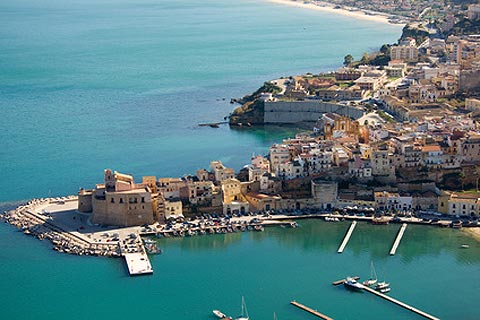

| Contact me | | | Ryan-Dennis | | | Dunn-Timothy | | | Ryan-Timothy | | | Ciaramitaro-MO | | | Ciaramitaro-MA | | | Ireland-Italy |

Located off the tip of the Italian peninsula, Sicily is the largest island in the Mediterranean Sea and measures 9,920 square miles (25,700 square kilometers).
As a result of its close proximity to both Italy (separated by the Strait of Messina by less than two miles) and North Africa (separated by less than 100 miles), Sicily has traditionally been regarded as a bridge between Africa and Europe. Officially considered one of the regions of Italy, Sicily has nevertheless enjoyed regional autonomy with extensive powers of self-government since 1946.
Sicily is comprised of nine provinces; Agrigento, Caltanissetta, Catania, Enna, Messina, Palermo, Ragusa, Siracusa, and Trapani, as well as numerous adjacent islands including the Egadi Islands, the Aeolian Islands, the Pelagie Islands, and the Ustica Islands. The terrain is largely mountainous with Europe's largest volcano, Mount Etna, representing the highest peak at 3,260 meters. The capital of Sicily is Palermo, which has a population of 500,000 and is the largest city in Sicily.
Sicily's ethnically diverse population of slightly over five million people reflects centuries of foreign rule. The major ethnic groups include native Sicilians, Arabs, Greeks, Spanish, and northern Italians. Although the vast majority of Sicilians are Roman Catholics, there are smaller numbers of Greek Orthodox Christians.
Palermo is Sicily's cultural, economic and touristic capital. A city rich in history, culture, art, music and food, it is located in the northwest of the island by the Gulf of Palermo in the Tyrrhenian Sea.
The feeling and temperatures are clearly mediterranean and if you tour the entire island you will see some of Italy’s most classic architecture.
The population of Palermo's urban area is estimated to be 855,285, it's metropolitan area is the fifth most populated in Italy. It is a big bustling city and unlike some Italian cities, the markets in Palermo are open every day.
Roman Catholicism is highly important in Palermian culture. The patron saint of the city is Saint Rosalia. Her feast day on July 15 is perhaps the biggest social event in the city.
Terrasini is located 19 miles (30 km) west of Palermo, between the mountains and the Gulf of Castellammare. Terrasini’s population works mainly in fishing and tourism. They say that the population triples during the summer. Bounding communes are: Carini, Cinisi, Partinico and Trappeto.
The name Terrasini derives from the nearby promontory of Capo Rama, which, with Capo San Vito opposite, forms the big Gulf of Castellammare, or ancient "Sinus Aegestanus". From the nearby gulf the territory began to be called "Terra Sinus", which then became Terrasini.
A chain of low mountains surrounds the town of Terrasini, which lies in a picturesque basin sloping down towards the sea. The populous town, probably of late medieval origin, was a feudal domain of the princes of Carini of the La Grua Talamanca house, which at the beginning of the 18th century were purchased from Baron Donato Gazzara.
The current (municipal) history of Terrasini can be traced back to 1836 with the unification of the two neighboring villages of Terrasini and Favarotta.
Today the Capo Rama promontory has been declared a nature reserve because of the richness and variety of its flora and fauna. The oldest part of the town is arranged in long blocks of low white houses, aligned along straight and clean streets, and all converging towards the sea.
In the town center stands the Santa Maria Sanctissima Grazia Catholic Church bordered by two eighteenth-century palazzos that belonged to the princes of Carini until the early 19th century. The Palazzo La Grua was recently restructured and today houses the Town Hall of Terrasini, while the Palazzo Cataldi preserves the original characteristics of an eighteenth-century noble palazzo.
| HOME | DOGTOWN |
| Bibliography | Oral history | Recorded history | Photos |
| YOUR page | External links | Walking Tour |